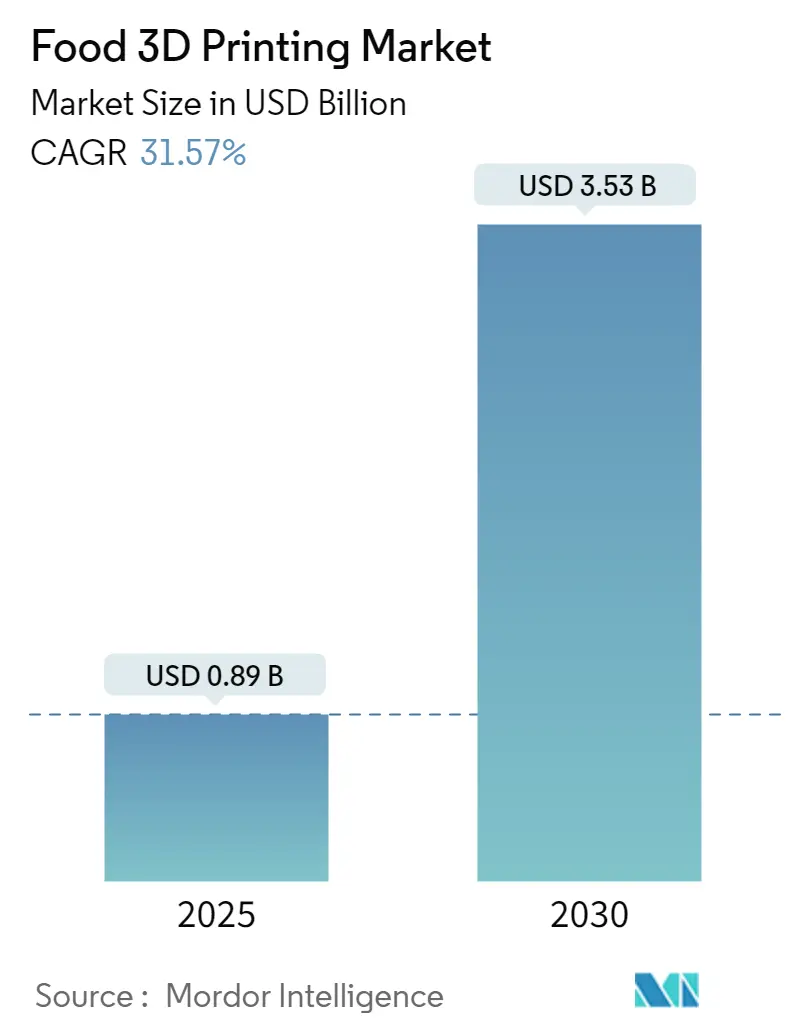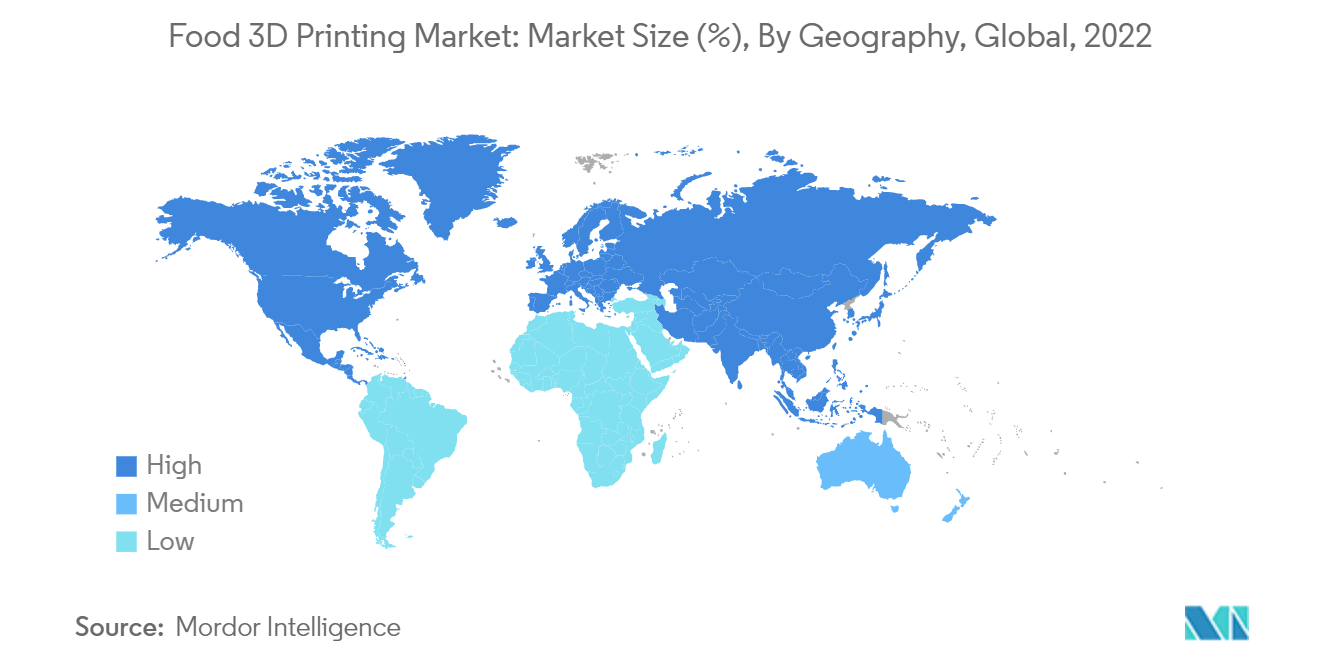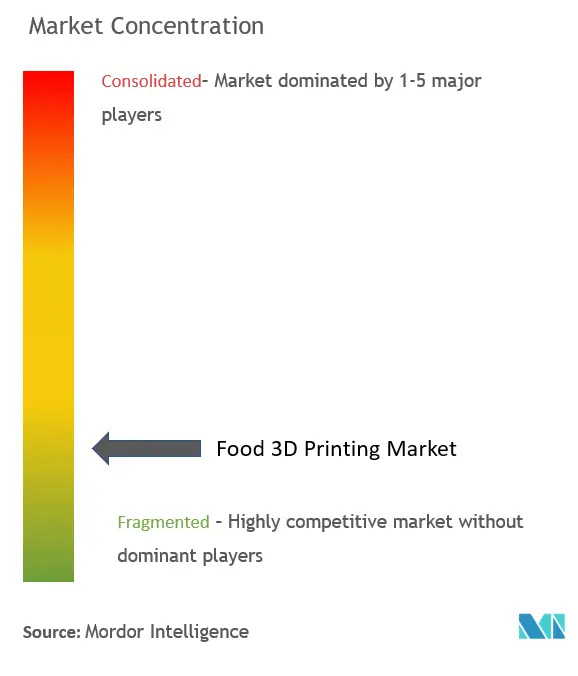
Food 3D Printing Market Analysis
The Food 3D Printing Market size is estimated at USD 0.89 billion in 2025, and is expected to reach USD 3.53 billion by 2030, at a CAGR of 31.57% during the forecast period (2025-2030).
3D printing technology has brought tremendous change in the food industry, with several companies worldwide trying their hand at 3D printing food. 3D printing technology involves a process known as additive manufacturing, wherein 3D deposition printers slowly deposit the layers of materials, one on top of the other, until a product is released. 3D printers are used for manufacturing and creating food that utilizes lasers, powdery materials, and nozzles, opening new doors for the customization of food products by delivering a potent mix of the right nutrients.
The 3D food printing market is driven by the underlying printing technology at the nascent stage of development and execution as far as the processed food sector is concerned. The stringent quality assurance and precise nutritional control achieved by the use of 3D printing is in itself a revolutionary concept. 3D food printing has also been introduced in the foodservice sector, with a growing number of chefs and cooks embarking on food innovation and culinary creativity by utilizing 3D food concepts. Hence, the demand for 3D printing in the food and beverage industry is expected to grow in the coming years.
Food 3D Printing Market Trends
Rising Consumer Demand for Customized Food Products
Rising consumer demand for customized and personalized food products is boosting the demand for 3D printers. Manufacturers are launching innovative 3D food printers for indulgence applications, such as chocolates, confectioneries, and pancakes, leading to an increased demand for 3D food printers at commercial and domestic levels globally. The market demand for mass customization is increasing, with manufacturers innovating different shapes, colors, flavors, nutrition, and textures. This customization is mainly done on food products like coffee, hamburgers, ice creams, cakes, biscuits, and confectionery. Technology is also one of the driving forces behind the 3D food printing market.

North America Holds the Largest Market Share
North America dominates the market due to the consumers' rapid adoption of 3D printing technology and its implementation in the daily food-making procedure. The huge market for confectioneries and bakery products, such as candies, chocolates, pizzas, and burgers, in North America and the increased demand for customized food products from the region make the region the largest market for 3D food printing technology. To promote 3D printing activities in the region, local governments are focusing on introducing programs that support 3D-printed food in the market.
For instance, in May 2022, the US federal government, with support from ASTRO (Applied Science & Technology Research Organization), initiated an AM Forward program that encourages and supports 3D food printing across small and medium-sized enterprises across the United States. With increasing exposure to the technological advancements of 3D printing in the food industry, the demand for incorporating 3D printing is expected to grow in the region.

Food 3D Printing Industry Overview
The food 3D printing market is competitive with the presence of numerous key players such as BeeHex, byFlow, CandyFab, Choc Edge, Nufood, Natural Machines, Systems, and Materials Research Corporation (SMRC). The mass customization of commoditized products and the ability to create complex food products quickly and inexpensively boosted the market. Companies in the market are strengthening their product portfolios by increasing their R&D investments. The key players in this market are increasingly undertaking partnerships and collaborations to develop new technologies.
Food 3D Printing Market Leaders
-
BeeHex
-
byFlow
-
Systems And Materials Research Corporation (SMRC)
-
Natural Machines
-
TNO
- *Disclaimer: Major Players sorted in no particular order

Food 3D Printing Market News
- In August 2022, the SavorEat, a startup operating across Israel, launched its plant-based burgers made from 3D printing techniques across the United States. The products offered in the portfolio are claimed to be kosher, vegan, and gluten-free in nature.
- In August 2021, NASA partnered with Texas-based Systems and Materials Research Corporation (SMRC) to develop both the 3D printers and the food for providing a healthy environment for astronauts, both physically and mentally. SMRC has already developed a pizza printing system that uses a combination of powdered foods containing the necessary nutrients. This technology would act as an automated way to produce meals in space.
- In July 2021, Redefine Meat commercially launched the world's first whole cuts of new meat in Rehovot, Israel. It is the first-ever category of plant-based whole cuts that achieve a product quality comparable to high-quality animal meat.
- In December 2020, Meat-Tech 3D Ltd announced an agreement to acquire 100% of the share capital of Peace of Meat PV, a pioneering Belgian producer of cultured avian products, for EUR 15 million, in a combination of cash and Meat-Tech ordinary shares in Ness Ziona, Israel.
Food 3D Printing Industry Segmentation
3D food printing is the process of manufacturing food products using a variety of additive manufacturing techniques. Most commonly, food-grade syringes hold the printing material, which is then deposited through a food-grade nozzle layer by layer. The food 3D printing market is segmented by product type, end user, and geography. The market is segmented by product type into chocolates and confectionery, bakery, meat and seafood, and other product types. By end user, the market is segmented into government, commercial, and residential. By geography, the market is segmented into North America, Europe, Asia-Pacific, South America, and Middle East and Africa. For each segment, the market sizing and forecasts have been done on the basis of value (in USD).
| By Product Type | Chocolates and Confectionery | ||
| Bakery | |||
| Meat and Seafood | |||
| Other Product Types | |||
| By End User | Government | ||
| Commercial | |||
| Residential | |||
| By Geography | North America | United States | |
| Canada | |||
| Mexico | |||
| Rest of North America | |||
| Europe | Spain | ||
| United Kingdom | |||
| Germany | |||
| France | |||
| Italy | |||
| Russia | |||
| Rest of Europe | |||
| Asia-Pacific | China | ||
| Japan | |||
| India | |||
| Australia | |||
| Rest of Asia-Pacific | |||
| South America | Brazil | ||
| Argentina | |||
| Rest of South America | |||
| Middle East and Africa | South Africa | ||
| Saudi Arabia | |||
| Rest of Middle East and Africa | |||
Food 3D Printing Market Research FAQs
How big is the Food 3D Printing Market?
The Food 3D Printing Market size is expected to reach USD 0.89 billion in 2025 and grow at a CAGR of 31.57% to reach USD 3.53 billion by 2030.
What is the current Food 3D Printing Market size?
In 2025, the Food 3D Printing Market size is expected to reach USD 0.89 billion.
Who are the key players in Food 3D Printing Market?
BeeHex, byFlow, Systems And Materials Research Corporation (SMRC), Natural Machines and TNO are the major companies operating in the Food 3D Printing Market.
Which is the fastest growing region in Food 3D Printing Market?
Asia Pacific is estimated to grow at the highest CAGR over the forecast period (2025-2030).
Which region has the biggest share in Food 3D Printing Market?
In 2025, the North America accounts for the largest market share in Food 3D Printing Market.
What years does this Food 3D Printing Market cover, and what was the market size in 2024?
In 2024, the Food 3D Printing Market size was estimated at USD 0.61 billion. The report covers the Food 3D Printing Market historical market size for years: 2019, 2020, 2021, 2022, 2023 and 2024. The report also forecasts the Food 3D Printing Market size for years: 2025, 2026, 2027, 2028, 2029 and 2030.
Our Best Selling Reports
Food 3D Printing Industry Report
Statistics for the 2025 Food 3D Printing market share, size and revenue growth rate, created by Mordor Intelligence™ Industry Reports. Food 3D Printing analysis includes a market forecast outlook for 2025 to 2030 and historical overview. Get a sample of this industry analysis as a free report PDF download.

.webp)

